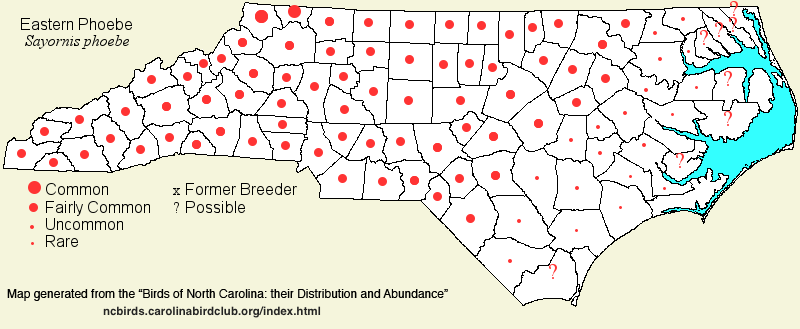 |  |
|
Eastern Phoebe - Sayornis phoebe TYRANNIDAE Members: | Search Common: Search Scientific: |
|
|
|||||||
| General Comments | The Eastern Phoebe is likely the most familiar of the 22 flycatcher species recorded in the state, as of 2022. It is the only one that winters regularly in the state, and it also nests across most of the state, except for lower Coastal Plain/coastal areas. It also frequently nests upon rafters of houses and other buildings, in close association with man. Breeding habitats are most often associated with small wooded streams, where there are nesting sites (especially bridges) nearby. Birds also nest on rock ledges and around farm buildings and other buildings (and not necessarily near water). The key feature is a horizontal (and usually man-made) structure for placing a nest. In winter, phoebes tend to associate with other birds such as Eastern Bluebirds and Pine Warblers, and forage for insects in a wide variety of habitats -- woodland edges, corn field stubble, pastures, and yards. Phoebe numbers across the overall range have been increasing for the past decade or two, likely owing to milder winters (and thus more insect food and greater survivability). | ||||||
| Breeding Status | Breeder | ||||||
| NC BRC List | Definitive | ||||||
| State Status | |||||||
| U.S. Status | |||||||
| State Rank | S5B,S5N | ||||||
| Global Rank | G5 | ||||||
| Coastal Plain | Winter resident, and summer resident in parts of the region. Breeds over the western two-thirds of the province -- east at least to Martin, Craven, and Duplin, to include a few areas in Croatan National Forest, but absent in essentially all coastal counties and over nearly all of the "Pamlimarle" Peninsula; fairly common in the western counties, but generally uncommon over the rest of the breeding range. A fairly common and increasing winter resident throughout, though not common on most barrier islands; can be common in the southern counties. Migrants arrive around early to mid-Oct and depart in Apr. Peak counts: 175, Cape Lookout, 5 Oct 2014. | ||||||
| Piedmont | Resident across all of the province, but with notable migratory movements. Fairly common breeder throughout, not obviously more numerous in one area over another. Fairly common in winter in the eastern and central portions, but less common (uncommon) farther west and in the foothills; numbers have increased in recent years. Peak counts: | ||||||
| Mountains | Resident across most of the province, with migratory movements. Fairly common and widespread breeder, up to about 5,500 feet elevation. Generally uncommon (but increasing) over most of the region in winter, being more numerous (can be fairly common) in low elevation valleys, and scarce in higher and more northern elevations. Peak counts: | ||||||
| Finding Tips |
In the breeding season, stopping at small bridges over wooded creeks, in the Piedmont or mountains, is sure to yield a phoebe after one to several stops. In winter, a few are normally seen in a day of birding, but there are no helpful locational hints. **** | ||||||
| Attribution | LeGrand[2023-03-24], LeGrand[2015-06-14], LeGrand[2012-08-17] | ||||||
| NC Map Map depicts all counties with a report (transient or resident) for the species. | Click on county for list of all known species. |
| NC Breeding Season Map Map depicts assumed breeding season abundance for the species. |  |